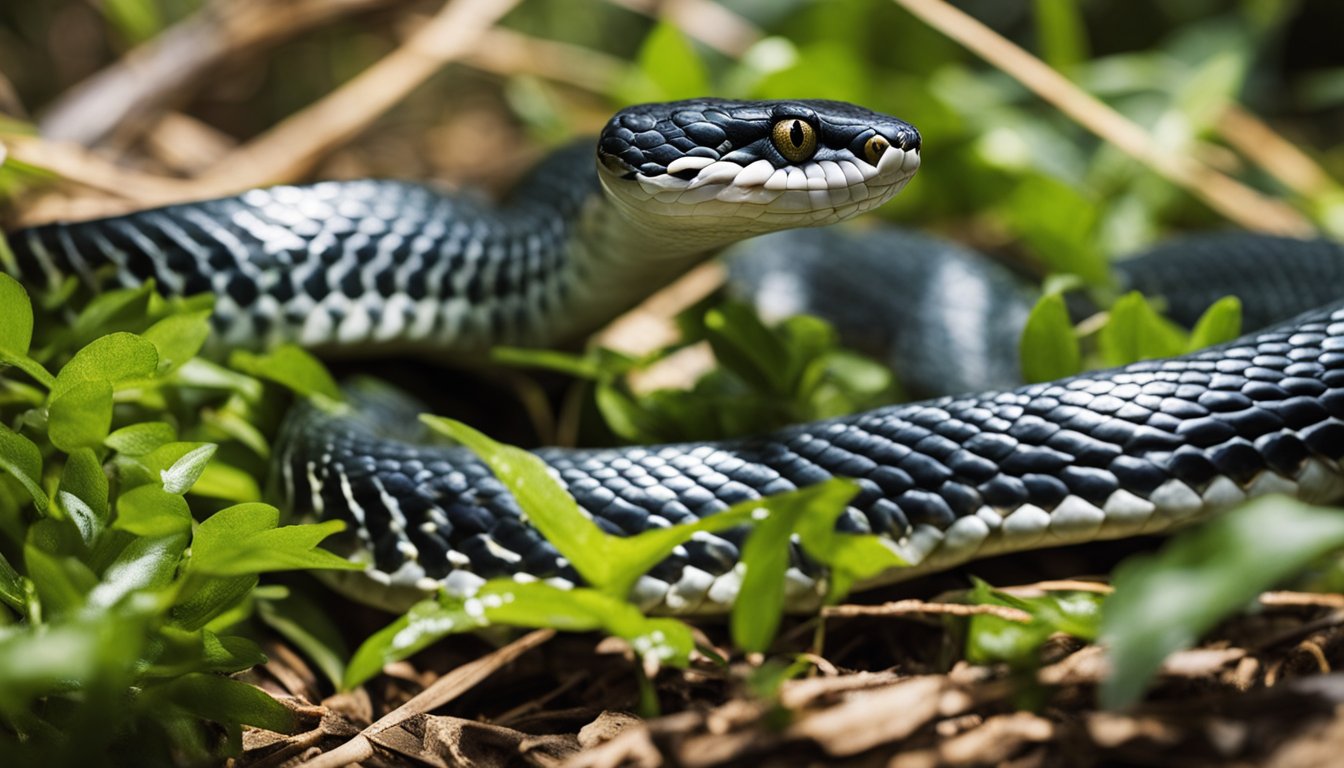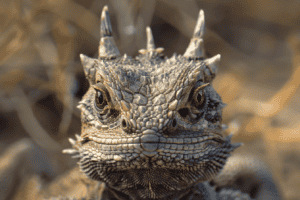Vipers are among the most fascinating and misunderstood creatures in the animal kingdom.
With their silent glide and iconic ‘S’ shaped slither, they capture the imagination of both young and old.
These snakes are known for their distinctive triangular heads and the presence of long, hinged fangs that they use to inject venom into their prey.
It’s the venom that earns them their dangerous reputation.
Yet, despite their notoriety, vipers play a crucial role in the balance of nature by controlling pest populations.

The world of vipers is diverse, with over 200 species spread across the globe from the steamy rainforests of South America to the sunbaked deserts of Africa.
These creatures are not only varied in their habitats but also in their colors and patterns, which help them blend into their surroundings.
When it comes to hunting, they are patient predators, often lying in wait for the perfect moment to strike.
This stealthy approach is aided by their exceptional heat-sensing ability, which allows them to detect warm-blooded prey, even in the dark.
Understanding vipers is essential for appreciating the complexity of ecosystems and the delicate balance of predator and prey relationships.
While their venom is indeed potent, often used for self-defense and securing a meal, it’s a marvel of nature’s design and has even contributed to medical advances, including treatments for blood pressure and blood clots.
Through learning about these slithery snakes, one can see the intricate tapestry of life and the importance of each thread, no matter how sharp or venomous it may seem.
Identifying Dangerous Vipers
When you’re out and about, spotting a viper might be both thrilling and a bit scary.
Vipers have distinct characteristics and live in specific habitats, so knowing these can help keep you safe and aware.
Characteristics of Vipers
Imagine you’re playing detective in the wild and you’re trying to spot a viper.
These snakes have a few standout features that can help solve the mystery. First off, they usually have a thick, heavy body with a short tail.
Vipers don’t win any awards for being long and slinky!
Their heads are a dead giveaway, often looking like a triangle thanks to those wide jaws they’re sporting.
What’s really special about them, though, is what they hide inside those jaws: long, hinged fangs that fold back when not in use.
Unlike some other sneaky snakes, when a viper says hello with a bite, it can inject venom into its unsuspecting guest.
Their eyes can also be mesmerizing with elliptical pupils that look like slits, kind of like a cat in the dark. And their scales?
Textured and keeled, which is a fancy way of saying they have a little ridge on each scale, like little speed bumps along their body.
It’s these unique traits that let you whisper to your friends, “Hey, that’s a viper!”
Habitat and Distribution
Now that you know what they look like, you’re probably wondering where vipers like to hang out.
Vipers are like the adventurous travelers of the snake world. They can be found slithering across various parts of the globe.
From the hot, dry sands of deserts to the cool understory of forests, these reptiles aren’t picky about their home.
Some prefer the sunny, Mediterranean climates where they can soak up the rays, while others make do in the rainforests, blending in with the dense foliage.
Regions like South America, Africa, Asia, and Europe all boast of having these venomous neighbors.
You won’t find them in Australia, though – it’s like they never caught wind of the travel brochures.
What’s really interesting is that some vipers, like the rattlesnakes in North America, have a special buzzer on their tails.
They shake it to say, “Back off!” to anyone who gets too close.
Next time you’re out exploring, keep your ears open—the sound of a rattle may just be a viper conducting its own little wilderness concert.
Venom: Nature’s Lethal Weapon

Venom is a sophisticated blend of proteins and enzymes, and serves as a highly effective hunting and defense mechanism for vipers.
This complex chemical brew not only immobilizes their prey but can also have a range of harmful effects on human physiology.
Venom Composition
Venom, in the world of vipers, is as unique as a fingerprint.
Vipers have specialized glands that produce venom, a toxic cocktail of various proteins, enzymes, and other molecules.
Each species tailors its own venom recipe that can cause different effects when introduced into a victim’s bloodstream.
One might wonder, what’s brewing inside those fangs?
It’s a mix of substances like hyaluronidase which helps venom spread through the body, and proteolytic enzymes, which break down tissue.
A viper’s venom might also contain neurotoxins, compounds that disrupt nerve function, and hemotoxins that target the circulatory system.
Imagine these ingredients coming together in a concoction that can immobilize a mouse in moments!
Effects of Viper Bites on Humans
When a viper bites, its venom can cause immediate and distressing symptoms.
Have you ever thought about why a tiny scratch from these reptiles isn’t just a mere ouch?
Vipers’ venom can lead to pain, swelling, and tissue damage at the bite site.
Internally, it might result in more serious symptoms like blood clotting disorders, low blood pressure, and even heart failure.
Can one imagine the body’s distress signals blaring as the venom infiltrates, disrupting vital systems?
That’s why it’s crucial to seek medical attention immediately if one encounters a viper’s wrath, as antivenom may be needed to counter these potent effects.
Safety Around Vipers

Understanding how to stay safe around vipers is crucial, with a focus on preventing encounters and knowing first aid for bites.
This information could be a lifeline.
Preventing Snake Encounters
Imagine walking through a forest; one must be as quiet as a mouse yet as vigilant as a hawk.
Vipers, with their exceptional camouflage, often go unnoticed until too close for comfort.
They prefer to avoid humans; hence, it is wise for people to reciprocate this desire. Sticking to well-trodden paths is a good start.
It’s also a smart move to avoid tall grasses and piles of leaves where vipers might hide.
When moving through their habitat, stepping heavily sends vibrations through the ground, which can alert snakes to one’s approach.
Tidiness around the house can reduce the likelihood of unwelcome viper guests; they are less likely to visit if there aren’t cozy hiding spots or rodent buffets to attract them.
It’s beneficial to keep yards clear of debris and to seal any gaps in building exteriors that might invite a curious viper indoors.
First Aid for Snakebites
If someone finds that a viper has made its mark, it’s essential to keep calm—a racing heart pumps venom faster through the body.
The bite area should not be cut or sucked, as often dramatized in movies. Instead, the affected limb must remain still and lower than the heart.
This can slow down the spread of venom.
Calling for medical help is the next critical step; they should take over with antivenom and any other necessary treatments.
While waiting for help, it’s advisable to remove any tight clothing or jewelry near the bite, as swelling is common.
Remembering the color and shape of the viper can aid medical professionals in providing the correct treatment.
It’s important to note that these scaly neighbors are not out to get you; they’d rather slide away without a fuss.
But if their paths cross with someone’s, it’s best to be prepared with knowledge and a cool head.
Frequently Asked Questions

Exploring the world of vipers brings up a treasure trove of intriguing questions.
They are equipped with fascinating and sometimes alarming features that many are curious about.
Here she’ll find answers to some of the most common curiosities about vipers, from their potent venom to their unique adaptations.
What are the unique characteristics of saw-scaled viper venom?
The venom of the saw-scaled viper is uniquely potent, containing a complex mix of enzymes and proteins.
It’s designed to efficiently immobilize their prey, causing disruption in the victim’s blood clotting ability.
The victim’s body might experience hemorrhage internally and externally without prompt treatment.
The speed at which these symptoms progress makes it one of the most feared venoms in the snake world.
Can you survive a bite from the most venomous snake, and what should you do if bitten?
Survival from a bite by the most venomous snake, such as the inland taipan, is possible with swift medical intervention.
If bitten, one must remain as calm and still as possible to slow the spread of venom.
Immediately seek emergency medical care, where antivenom can be administered to counteract the effects.
What super cool adaptations do vipers have that make them such fascinating creatures?
Vipers boast super cool adaptations that help them thrive.
They have heat-sensing pits between their eyes and nostrils, allowing them to detect warm-blooded prey even in darkness.
Their hinged fangs fold back when not in use, and they can strike with precision to deliver their venom.
These physical adaptations make vipers skilled hunters of the reptile kingdom.
Which regions of the world are home to the largest varieties of vipers?
The largest variety of vipers can be found across continents in Asia, Africa, Europe, and the Americas.
They tend to favor warmer regions and a diverse set of habitats from deserts to rainforests.
Countries like India and Brazil are especially notable for their diverse viper populations.
How can you identify the most dangerous types of vipers out in the wild?
Identifying the most dangerous vipers in the wild includes observing distinctive features such as their triangular-shaped heads, distinctive patterning, and the presence of vertical pupils.
They may also have keeled scales, which add to their rough-textured appearance.
Caution and distance are of the utmost importance when identifying these creatures in their natural habitats.
Are there any non-venomous vipers, and what differentiates them from their venomous cousins?
No true vipers are non-venomous; all members of the Viperidae family possess some form of venom.
However, some related snakes have a less toxic venom or are not as adept at delivering it.
Venomous vipers are generally characterized by their solenoglyphous fangs, which they use to inject venom, a trait not found in their non-venomous cousins.









